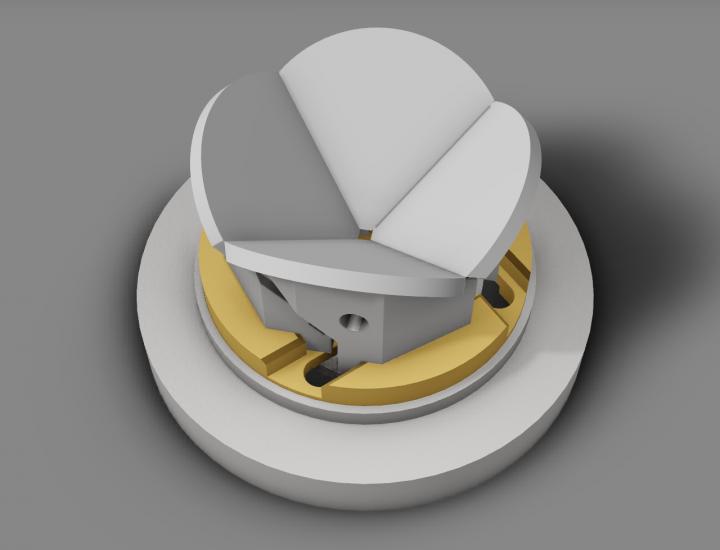Technology advance could enable space-based atomic clocks, improving communications and GPS navigation
WASHINGTON — Although quantum technology has proven valuable for highly precise timekeeping, making these technologies practical for use in a variety of environments is still a key challenge. In an important step toward portable quantum devices, researchers have developed a new high-flux and compact cold-atom source with low power consumption that can be a key component of many quantum technologies.
“The use of quantum technologies based on laser-cooled atoms has already led to the development of atomic clocks that are used for timekeeping on a national level,” said research team leader Christopher Foot from Oxford University in the U.K. “Precise clocks have many applications in the synchronization of electronic communications and navigation systems such as GPS. Compact atomic clocks that can be deployed more widely, including in space, provide resilience in communications networks because local clocks can maintain accurate timekeeping even if there is a network disruption.”
In The Optical Society (OSA) journal Optics Express, S. Ravenhall, B. Yuen and Foot describe work carried out in Oxford, U.K. to demonstrate a completely new design for a cold atom source. The new device is suitable for a wide range of cold-atom technologies.
“In this project we took a design we made for research purposes and developed it into a compact device,” said Foot. “In addition to timekeeping applications, compact cold-atom devices can also be used for instruments for gravity mapping, inertial navigation and communications and to study physical phenomena in research applications such as dark matter and gravitational waves.”
Cooling atoms with light
Although it may seem counterintuitive, laser light can be used to cool atoms to extremely low temperatures by exerting a force that slows the atoms down. This process can be used to create a cold-atom source that generates a beam of laser-cooled atoms directed toward a region where precision measurements for timekeeping or detecting gravitational waves, for example, are carried out.
Laser cooling usually requires a complicated arrangement of mirrors to shine light onto atoms in a vacuum from all directions. In the new work, the researchers created a completely different design that uses just four mirrors. These mirrors are arranged like a pyramid and placed in a way that allows them to slide past each other like the petals of a flower to create a hole at the top of the pyramid through which the cold atoms are pushed out. The size of this hole can be adjusted to optimize the flow of cold atoms for various applications. The pyramid arrangement reflects the light from a single incoming laser beam that enters the vacuum chamber through a single viewport, thus greatly simplifying the optics.
The mirrors, which are located inside the vacuum region of the cold-atom source, were created by polishing metal and applying a dielectric coating. “The adjustability of this design is an entirely new feature,” said Foot. “Creating a pyramid from four identical polished metal blocks simplifies the assembly, and it can be used without the adjustment mechanism.”
Better measurements with more atoms
To test their new cold-atom source design, the researchers constructed laboratory equipment to fully characterize the flux of atoms emitted through a hole at the apex of the pyramid.
“We demonstrated an exceptionally high flux of rubidium atoms,” said Foot. “Most cold-atom devices take measurements that improve with the number of atoms used. Sources with a higher flux can thus be used to improve measurement accuracy, boost the signal-to-noise ratio or help achieve larger measurement bandwidths.”
The researchers say that the new source is suitable for commercial application. Because it features a small number of components and few assembly steps, scaling up production to produce multiple copies would be straightforward.
###
Images and engineering drawings of the device are available at https:/
Paper: S. Ravenhall, B. Yuen, C. Foot, “High-flux, adjustable, compact cold-atom source,” Opt. Express, 29, 14, 21143-21159 (2021).
DOI: https:/
About Optics Express
Optics Express reports on scientific and technology innovations in all aspects of optics and photonics. The bi-weekly journal provides rapid publication of original, peer-reviewed papers. It is published by The Optical Society (OSA) and led by Editor-in-Chief James Leger of the University of Minnesota, USA. Optics Express is an open-access journal and is available at no cost to readers online at OSA Publishing.
About The Optical Society
Founded in 1916, The Optical Society (OSA) is the leading professional organization for scientists, engineers, students and business leaders who fuel discoveries, shape real-life applications and accelerate achievements in the science of light. Through world-renowned publications, meetings and membership initiatives, OSA provides quality research, inspired interactions and dedicated resources for its extensive global network of optics and photonics experts. For more information, visit osa.org.
Media Contact:
Media Contact
James Merrick
[email protected]
Original Source
https:/
Related Journal Article
http://dx.





